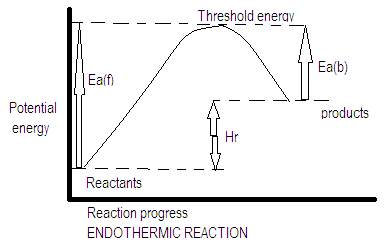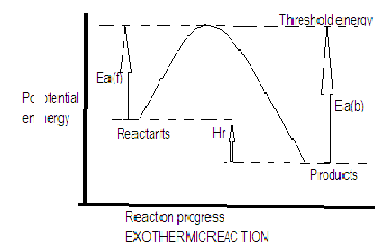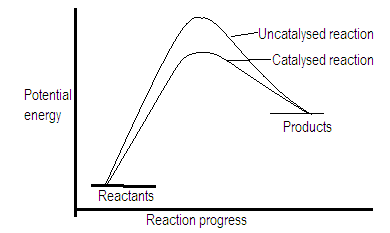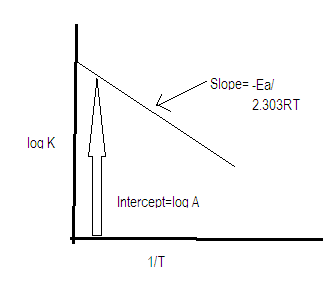
Write short notes on:
(I) Activation energy
(ii) Arrhenius equation
Answer
573.9k+ views
Hint: The concept of the above equation and energy is evolved from chemical kinetics.
Complete step by step solution: rate constant in chemical kinetics is affected by temperature, nature of reactant and catalyst. Threshold energy is the minimum amount of energy at which reaction takes place.
Activation energy: the energy given to the reactant to reach the threshold value of energy is called activation energy.


Activation energy is different for both exothermic and endothermic reactions. For endothermic reaction as shown in the diagram Ea(f) is the activation energy for forward reaction and Ea(b) is the activation energy for backward reaction. Enthalpy of a reaction$\Delta {{\rm H}_r} = {E_{{a_f}}} - {E_{{a_b}}}$ . In an endothermic reaction reactants have a lower potential energy as compared to the products because we know that heat is released during endothermic reaction whereas in exothermic reaction heat is absorbed hence the potential energy of the reactants is greater than the potential energy of the products.

Positive catalyst lowers the activation energy of the reaction by changing the reaction path and hence increases the rate of reaction.
(ii) Arrhenius equation: the rate constant of a reaction is a function of temperature. It is related to temperature by the Arrhenius equation.
$K = A{e^{\dfrac{{ - {E_a}}}{{RT}}}}$
Where k is the rate constant, A is the frequency factor or pre exponential factor or Arrhenius constant, T is the absolute temperature and Ea is the activation energy of the reaction in J/mole.
Taking log on both the sides in the above written Arrhenius equation we get:
Log K=log A-$\dfrac{{{E_a}}}{{2.303RT}} = \log \dfrac{{{k_1}}}{{{k_2}}} = \dfrac{{{E_a}}}{{2.303RT}}[\dfrac{1}{{{T_1}}} - \dfrac{1}{{{T_2}}}]$

Note: In Arrhenius equation the factor ${e^{\dfrac{{ - {E_a}}}{{RT}}}}$is the fraction of effective collisions and A represents the number of total bimolecular collision taking place in unit volume and in unit time.
Complete step by step solution: rate constant in chemical kinetics is affected by temperature, nature of reactant and catalyst. Threshold energy is the minimum amount of energy at which reaction takes place.
Activation energy: the energy given to the reactant to reach the threshold value of energy is called activation energy.


Activation energy is different for both exothermic and endothermic reactions. For endothermic reaction as shown in the diagram Ea(f) is the activation energy for forward reaction and Ea(b) is the activation energy for backward reaction. Enthalpy of a reaction$\Delta {{\rm H}_r} = {E_{{a_f}}} - {E_{{a_b}}}$ . In an endothermic reaction reactants have a lower potential energy as compared to the products because we know that heat is released during endothermic reaction whereas in exothermic reaction heat is absorbed hence the potential energy of the reactants is greater than the potential energy of the products.

Positive catalyst lowers the activation energy of the reaction by changing the reaction path and hence increases the rate of reaction.
(ii) Arrhenius equation: the rate constant of a reaction is a function of temperature. It is related to temperature by the Arrhenius equation.
$K = A{e^{\dfrac{{ - {E_a}}}{{RT}}}}$
Where k is the rate constant, A is the frequency factor or pre exponential factor or Arrhenius constant, T is the absolute temperature and Ea is the activation energy of the reaction in J/mole.
Taking log on both the sides in the above written Arrhenius equation we get:
Log K=log A-$\dfrac{{{E_a}}}{{2.303RT}} = \log \dfrac{{{k_1}}}{{{k_2}}} = \dfrac{{{E_a}}}{{2.303RT}}[\dfrac{1}{{{T_1}}} - \dfrac{1}{{{T_2}}}]$

Note: In Arrhenius equation the factor ${e^{\dfrac{{ - {E_a}}}{{RT}}}}$is the fraction of effective collisions and A represents the number of total bimolecular collision taking place in unit volume and in unit time.
Recently Updated Pages
A man running at a speed 5 ms is viewed in the side class 12 physics CBSE

State and explain Hardy Weinbergs Principle class 12 biology CBSE

Which of the following statements is wrong a Amnion class 12 biology CBSE

Two Planoconcave lenses 1 and 2 of glass of refractive class 12 physics CBSE

The compound 2 methyl 2 butene on reaction with NaIO4 class 12 chemistry CBSE

Bacterial cell wall is made up of A Cellulose B Hemicellulose class 12 biology CBSE

Trending doubts
What are the major means of transport Explain each class 12 social science CBSE

Which are the Top 10 Largest Countries of the World?

Draw a labelled sketch of the human eye class 12 physics CBSE

Explain sex determination in humans with line diag class 12 biology CBSE

The pH of the pancreatic juice is A 64 B 86 C 120 D class 12 biology CBSE

Give 10 examples of unisexual and bisexual flowers




